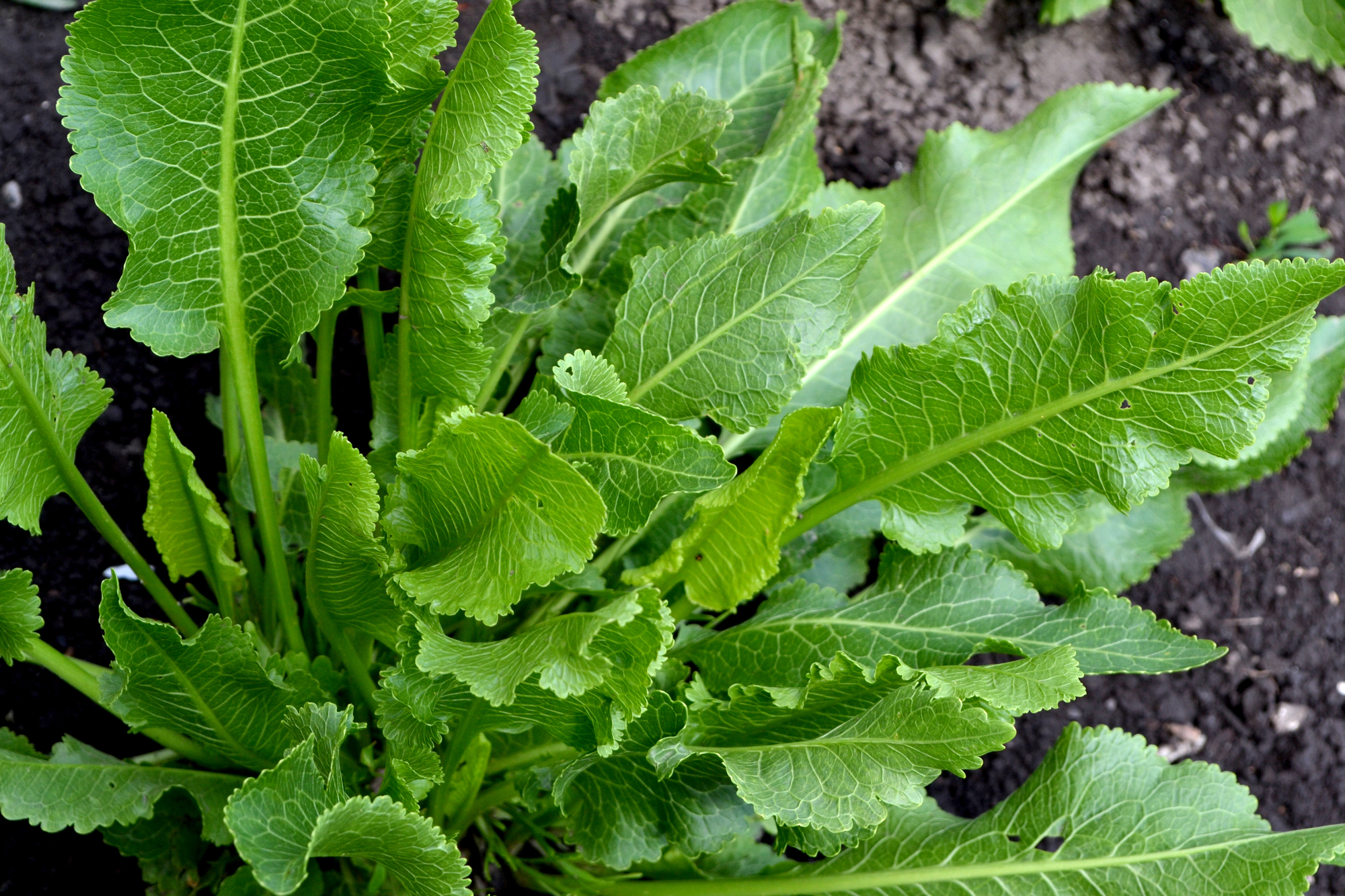Horseradish Donation Tracker
Quick Links: How & Where to Grow | Temperature | How to Care For | Harvest Signs | Harvesting | Pests | Companions | Varieties | Preservation | Recipes | Michigan Tips | Fun Facts
🌱 How & Where to Grow Horseradish:
- Plant root cuttings in early spring as soon as soil can be worked.
- Choose permanent location – VERY invasive! Consider containers or barriers.
- Plant cuttings 12-18 inches apart at 45° angle, 2-3 inches below soil.
- Space rows 30 inches apart if planting multiple.
- Sunlight: Full sun to partial shade (6+ hours preferred).
- Soil Type: Deep, rich, well-drained soil with pH 6.0-7.0.
- Soil Amendment: Work in compost deeply – roots can go 3+ feet down.
Warning: Any root piece left in soil will regrow – choose location wisely or grow in buried containers!
🌡️ Temperature Guidance:
Hardy perennial. Plant when soil workable. Needs cold for best flavor.
- Planting: Early spring when soil reaches 45°F.
- Growing: Thrives in cool temperatures 60-75°F.
- Cold requirement: Needs several hard frosts for best root development.
- Extremely cold hardy – survives -30°F once established.
- Leaves die back after frost but roots remain viable.
Michigan’s cold winters are perfect – they trigger dormancy and intensify flavor!
💧 How to Care for:
- Consistent Moisture: Important for tender, non-woody roots.
- Watering: 1-2 inches weekly during active growth.
- Mulch: 2-3 inches to retain moisture and suppress weeds.
- Fertilizer: Feed monthly during first year, then just spring application.
- Weed Control: Critical when young – established plants shade out weeds.
📏 Harvest Signs:
Harvest late October after frost. Best flavor after several freezes.
- First year: Let plants establish – harvest lightly if at all.
- Mature plants: Wait until after hard frost kills foliage.
- Root size: Main roots should be 8-12 inches long, 1-2 inches diameter.
- Best timing: Late fall through early spring while dormant.
- Roots harvested in hot weather are woody and bitter.
Cold weather transforms starches to sugars and intensifies the signature heat!
🧺 Harvesting:
Dig carefully from side. Remove all root pieces or they’ll regrow!
- Use spading fork to loosen soil 12+ inches from crown.
- Dig deep – main roots can extend 2-3 feet down.
- Save pencil-thick roots for replanting if desired.
- Remove ALL pieces to prevent unwanted spread.
- Process quickly or store whole roots – grated horseradish loses potency.
🪲 Michigan Pests:
Remarkably pest-free! Occasional flea beetles, root rot in wet soil.
- Flea beetles: May attack leaves but rarely affect roots.
- Root rot: Only in waterlogged soil – ensure good drainage.
- Imported crucifer weevil: Rare but can damage roots.
- The pungent oils that give horseradish its heat also repel most pests!
- More often used AS a pest deterrent for other crops.
🫱🏽🫲🏼 Companions:
Good with potatoes, fruit trees. Plant at corners to contain spread.
- Potatoes: Traditional companion – may deter Colorado potato beetles.
- Fruit trees: Plant at drip line to deter borers.
- Avoid: Other brassicas which share diseases.
- Isolation: Best grown alone due to invasive nature.
- Corner plantings: Traditional placement to contain spread.
🌿 Varieties:
‘Maliner Kren’, ‘Big Top Western’, ‘Bohemian’.
- ‘Maliner Kren’: Standard variety, good disease resistance, hot!
- ‘Big Top Western’: Large roots, widely adapted, very pungent.
- ‘Bohemian’: Heirloom, earliest to harvest, excellent flavor.
- ‘Variegata’: Ornamental with cream-splashed leaves, edible roots.
- Most garden centers sell generic horseradish which works fine.
🫙 Preservation:
Store in damp sand 10 months. Grate fresh, add vinegar for heat control.
- Whole roots: Store in damp sand/sawdust at 32-35°F for 10-12 months.
- Refrigerator: Wrap in damp paper towels, plastic bag, 4-6 months.
- Prepared: Grate and mix with vinegar – lasts 4-6 weeks refrigerated.
- Freezing: Grate and freeze in ice cube trays with vinegar.
- Heat control: Add vinegar immediately for mild, wait 3 minutes for hot!
🧑🏽🍳 Recipes:
Prepared horseradish, cocktail sauce, horseradish cream, prime rib companion.
- Classic prepared horseradish – just grated root and white vinegar.
- Cocktail sauce with ketchup and horseradish.
- Horseradish cream sauce for beef.
- Beet horseradish (chrein) – traditional Jewish condiment.
- Add to mashed potatoes for amazing flavor kick!
✋🏼 Michigan Tips:
- Plant in buried bottomless containers to control spread.
- Michigan’s winters provide perfect dormancy conditions.
- Harvest after Thanksgiving for strongest flavor.
- Spring-dug roots are milder than fall.
- Consider corner of property away from other gardens.
- One plant provides enough for most families!
🧠 Fun Facts:
- 3,000+ year cultivation history – mentioned in Bible’s Passover Seder.
- Not related to radishes and “horse” likely means “coarse” or “strong.”
- Contains more vitamin C than oranges!
- The heat comes from volatile oils released when cells are crushed.
- Unlike hot peppers, the heat hits your sinuses, not your tongue.
- Was used medicinally before becoming a condiment.
- The enzyme that creates heat is destroyed by heat – never cook it!
- Commercial wasabi is usually horseradish with green food coloring.


0 Comments